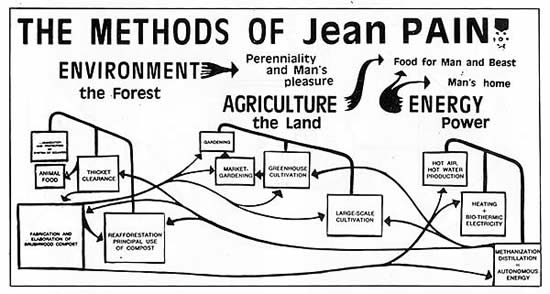BIO-GAS
Bio-gas is the by-product given off from decaying matter as it makes it way back into the universal system to be brought back anew as life in another form. This gas can be captured and burned as a source of energy through a biogas digester.
.
.
Biogas digester

biogas digester, methane production.
Bio-gas digesters are just that, they digest biological matter into a slurry that gives off a gas that can be captured and burned later like any other natural type of gas. Biological matters consist of things such as animal and human wast and vegetation. Once put into the digester the decomposing cycle is accelerated creating a gas effect that produces methane. This gas can than be directed anywhere that other gases are used for such things as cooking and heating or making electricity. It can be fitted to a boiler system for radiant heating as well. Small engines can also be fitted to this source of fuel. Combined with a Geo-thermal system the possibilities are endless from steam power to electricity and beyond and then if you combine a composting coils system into the slurry tank you are so far off the grid you will need to put on your acorn hat and pinch yourself. The slurry byproduct is then then be turned back into fertilizer, uh oh, I think we just created a symbiotic system, be careful or you will end up self-sufficient and independent. This truly is the fuel of the future. Raw Methane Gas is one of the prime polluters that is contributing to the eco-break down that we are experiencing right now in our life time known as the greenhouse effect and one of the others is soot. Soot is caused from carbons that are not thoroughly combusted (via wood cooking and heating) and then are released into the atmosphere. So we can solve a portion of this problem by harvesting methane from sources and later burning it thoroughly to create heat and electricity as well as cooking and lighting fuel, there by reducing the need for soot causing carbons such as coal and wood. Once burned or ignited methane becomes Co2 which is 10 times less harmful to the environment. Plants absorb Co2 and turn it into Oxygen. How readily available is methane gas you ask? Well it's everywhere and you're sitting in it right now and probably less the 20 ft from you right now there is a methane gas producing factory in your kitchen called the garbage pail, when that bad smell starts to make itself known in the air the process has begun. That's how readily available it is. We don't need to punch holes in the earth to get it with the abundance of it all around us on the surface and more to come everyday. You can build a full on community system out of bricks and mortar or you can build a personal one right in your backyard with a couple of 55 gallon drums. Once you have made your system you will need to monitor it for gas production and leaks, this is a flammable and explosive (actually implosive) substance that we are not saying is easy or safe, but under the proper conditions and sufficient training and research it can be done. Methane gas will only produce between 85 and 105 degrees Fahrenheit, anything less and the gas producing microbes will stay dormant and anything more they will die off. Before the industrial revolution in the 1700's methane was captured from the sewers of European cities and used to light street lamps.
>>WARNING<<
Once again there are many dangers involved in biogas processing from fire and explosion to asphyxiation and contamination. This is not a weekend worrier project. All to often articles are written, formulas told and how to's given online and other areas all to easily. Please do your research and buy some books or talk to someone in the field or look on line for local courses being taught in your area. Oxygen and Methane do not mix, they must be kept separated at all times to prevent a fire or explosion. Oxygen is the vehicle in which incendiaries need to ignite. With a little prudence you can learn how to safely make and process methane for your own personal use. Find more information as well as DIY's and manuals in our >LIBRARY<
>>WARNING<<
Once again there are many dangers involved in biogas processing from fire and explosion to asphyxiation and contamination. This is not a weekend worrier project. All to often articles are written, formulas told and how to's given online and other areas all to easily. Please do your research and buy some books or talk to someone in the field or look on line for local courses being taught in your area. Oxygen and Methane do not mix, they must be kept separated at all times to prevent a fire or explosion. Oxygen is the vehicle in which incendiaries need to ignite. With a little prudence you can learn how to safely make and process methane for your own personal use. Find more information as well as DIY's and manuals in our >LIBRARY<
INFORMATION LINKS
|
This is a BioGas digester kitchen design from Phillips.
While only a test design hopefully this is something that isn't to far off in the future, directly from our past.
|
Methane Power from the past.
wMethane is as old as time, as long as there has been matter to decay there has been methane. Gas bag vehicles were a big thing in the times of war because of gas shortages caused by the diversion of fuels to the war efforts, The Chinese have been tapping natural gas for decades, The historic data can be traced back to The Western Han Dynasty, 100 BC. stringing a series of bamboo shafts as pipping they would plum their villages for cooking. China is no one of if not the biggest user of methane digesters in the world, at over 2 million systems in the country they are ahead of the game.


















